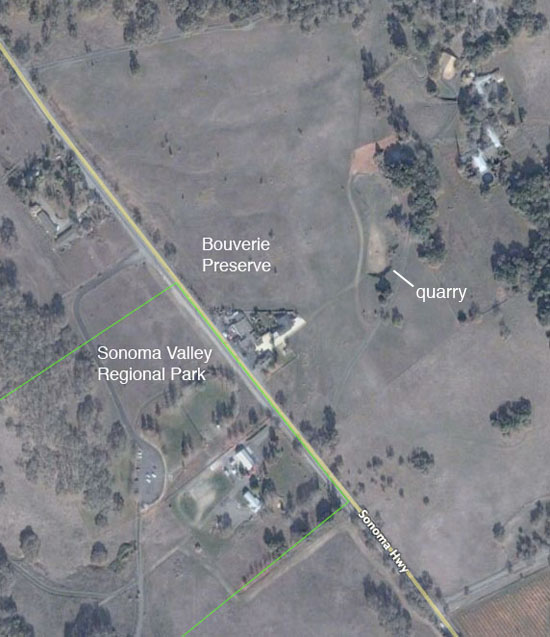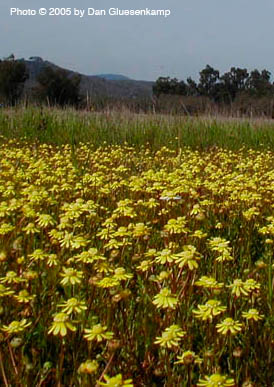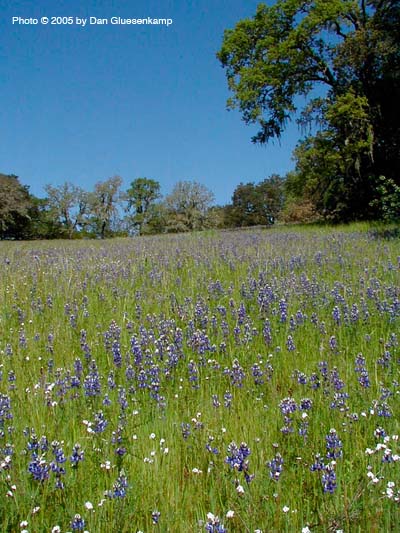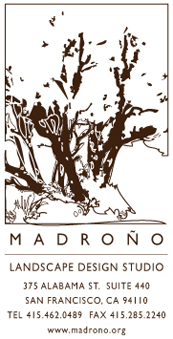Water paints with shifting colors the divided contours of the Valley of the Moon in Sonoma, California. The blues and greens of oak and bay forests on protected north-facing slopes complement the fire and earth tones of chaparral on the south-facing sides. Here at the southern end of the basin, riotous riparian woodlands follow snaking Stuart Creek through a steep canyon to Agua Caliente, the pepper of volcanic springs beneath the valley floor. Lowland meadows collect water in seasonal puddles, where vivid wildflowers come and go with the equinox.
 On two sides of the Old Sonoma Highway, one such meadow is divided by two authorities. The southwest side of the field falls within the boundaries of Sonoma Valley Regional Park, a public 162-acre parcel near Glen Ellen; the northeast side belongs to the Bouverie Preserve, a 500-acre jewel in the private necklace of Audubon Canyon Ranch.
On two sides of the Old Sonoma Highway, one such meadow is divided by two authorities. The southwest side of the field falls within the boundaries of Sonoma Valley Regional Park, a public 162-acre parcel near Glen Ellen; the northeast side belongs to the Bouverie Preserve, a 500-acre jewel in the private necklace of Audubon Canyon Ranch.
A former quarry beside the Bouverie visitor center (rumored to have supplied the stone for the nearby Jack London House) is today a vernal pool, a depression of hardpan that fills with water in winter and goes bone dry in summer. Smaller pools and swales sweep the adjacent meadow in a network of linked seasonal wetlands -- up to Highway 12, of course -- then continue as another isolated system on the other side of the road. Spring sees the transition from flood to drought in these unforgiving flats, a mere sliver of time in which a succession of highly adapted native plants take the stage and dance with the reaper for a week or two, then disappear again.
Just now in the quarry, popcorn flower (Plagiobothrys stipitatus var. micranthus) and wooly marbles (Psilocarphus brevissimus var. brevissimus) are on the back side of their annual appearance. Both are called "belly flowers" because you have to get down on your belly to see them. The popcorn flower has a thin green stem and tiny white flowers; the wooly marbles look like felt, a sweep of low-growing grey-green shaggy foliage and a post-bloom seed pod like cotton balls; both species occur in sweeps at the edges of vernal pools and flats. These flowers start to fade in May, and next month they will be gone -- but we can hope that insect pollinators have done their duty, to coax the setting of seed that will bring them back next year.
Last month saw the rise and fall of the annual dwarf downingia or Downingia pusilla, a rare plant in California (though common in the vernal pools of Chile) that sprouts to a mature height of one inch. Fifty of these blossoms could fit on the face of a penny; each resembles a tiny white five-pointed star, with a three-lobed upper lip touched in gold. This year's plants have already passed on, but their twisted seeds lie waiting in the sun-baked earth, patient for the return of the rains.
 Before that it was Blennosperma nanum var. nanum, a small but showy annual with a bright yellow bloom in March, mass quantities of which light up the margins of vernal pools in golden rings. The rays of this micro-sunflower are thrown back as if in joy, thrusting up the disc flowers to the light in a gesture of enthusiasm or Eros. But it too has followed the mandate of its annual lifecycle, and won't be seen again until next spring. Collectors, take note -- the genus name is Greek for "slimy seed."
Before that it was Blennosperma nanum var. nanum, a small but showy annual with a bright yellow bloom in March, mass quantities of which light up the margins of vernal pools in golden rings. The rays of this micro-sunflower are thrown back as if in joy, thrusting up the disc flowers to the light in a gesture of enthusiasm or Eros. But it too has followed the mandate of its annual lifecycle, and won't be seen again until next spring. Collectors, take note -- the genus name is Greek for "slimy seed."
These sequential waves of dominant species coming and going are parallel to the natural patterns that occur in any ecosystem -- but here the fast rate of succession makes it more dramatic.
Once upon a time, the native plant communities of the vernal pools enjoyed a high degree of invulnerability from competition: no other plants could live under such extreme conditions, especially in the nutrient-poor substrate that results from a centuries-long cycle of rain-fed inundation and sun-driven evaporation. But the airborne pollution of mankind has leveled the playing field: smog settles in microscopic particles upon the land, altering soil chemistry and fertility. Studies have revealed that Bay Area smog sends "dry deposits" of nitrogen molecules into the soil of adjacent wildlands at the approximate annual rate of 20 pounds per acre, the equivalent of five large bags of concentrated industrial lawn fertilizer per acre per year via the tailpipes of our cars.
Emboldened by all that nutritious nitrogen, weedy European grasses are storming the vernal swales. Vigorous interlopers like ripgut, wild oats, Italian rye, and other monoculturalists have marched down from the hillsides, as they have done across the entire state; their taller habit shades out the low-growing natives and annihilates them.
The ratio of exotic to native in California is now so lopsided, we can never turn back the tide. But we can manage the invasion. Better yet, we can learn from it.
 On the Bouverie side of the road, ecologist Dan Gluesenkamp keeps an eye on the meadow. He mows certain patches, pulls weeds by hand, and recently introduced a grazing program. Just this month, he and "conservation cowboy" Joe Pozzi (a fourth-generation Sonoma Co. rancher) fenced the perimeter and introduced two dozen head of cattle. These animals prefer to eat the nitrogen-rich exotic plants, rather than the low-nitrogen natives, and their occasional nibbles on native upland bunchgrasses just mimic the mouths of elk and other now-extirpated ungulates. The cows are a boon for the beleaguered native plants. Many open space managers consider moderate grazing a crucial element of modern grassland management, and perhaps vernal swales should fall under this rubric as well. In a few months or so, the cattle will be moved along to avoid overgrazing.
On the Bouverie side of the road, ecologist Dan Gluesenkamp keeps an eye on the meadow. He mows certain patches, pulls weeds by hand, and recently introduced a grazing program. Just this month, he and "conservation cowboy" Joe Pozzi (a fourth-generation Sonoma Co. rancher) fenced the perimeter and introduced two dozen head of cattle. These animals prefer to eat the nitrogen-rich exotic plants, rather than the low-nitrogen natives, and their occasional nibbles on native upland bunchgrasses just mimic the mouths of elk and other now-extirpated ungulates. The cows are a boon for the beleaguered native plants. Many open space managers consider moderate grazing a crucial element of modern grassland management, and perhaps vernal swales should fall under this rubric as well. In a few months or so, the cattle will be moved along to avoid overgrazing.
Gluesenkamp is gathering data on the multi-level changes wrought by the grazing program upon the plant and animal populations of the vernal swales. Changing plant composition will influence the insect and annelid communities, for example, which could affect the diets of local birds. These ever-widening spheres of influence are deep and interconnected beyond measure -- but Gluesenkamp gives it a try. Using smaller "exclosures" within the larger enclosure, he charts the rise and fall of exotic slugs in a system with or without cows. He also keeps similar exclosures on the margins of the upland forest to study the effects of the exploding populations of exotic wild turkeys. Ongoing plant surveys triage struggling species, monitor ongoing operations, and assess future management choices, all based on observable data.
Across the road in Sonoma Valley Regional Park, by contrast, allocations for resource observation and protection are currently negligible to nil, and the only fenced enclosure designed for animals is a one-acre off-leash dog park. Unfortunately, the hound playground was built within the reaches of the vernal swale system, so that canine waste has now surely added itself to the complex seasonal wetland equation.
But plans are afoot for the regional park and the Bouverie preserve to cooperate on an important new project: the study and protection of rare and endangered Blennosperma bakeri, which was spotted here in March 2004 growing on the regional park side of the road. Gluesenkamp hopes for a joint effort with the park, starting with a foundation of science -- measure the levels of nitrogen deposition here from Highway 12, count the B. bakeri plants (somewhere between 100 and 100,000), and determine if the population is expanding or shrinking. This information would inform the direction of a nascent (and, one hopes, ongoing) management program. A good, easy first step would be simply to mow the exotic grasses in the swales annually, early in the season -- some would question why this hasn't already been done. Lack of funding appears to be the primary obstacle, or perhaps inertia.
There's a fine line between laissez-faire and neglect, between getting better and getting worse, between lives that go dormant as reproductive strategy and species that are dead. Education and public awareness can play an important role in lobbying for change. We work for the seeds of the future, wherever they may fall.
# # #
Geoffrey Coffey teaches classes for Native Spaces, a non-profit that promotes the use of California native plants in the built landscape. He is the founder of Madroño landscape design studio, a principal of Bay Natives nursery, and a freelance writer for the San Francisco Chronicle.

